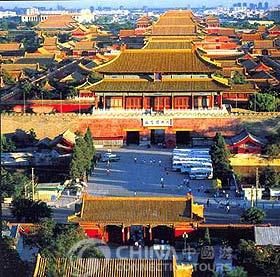 Manchu culture is the centerpiece of the Imperial Palace in Shenyang, capital of northeastern China's Liaoning Province. Founded in 1624, the 380-year-old Shenyang Imperial Palace is one of the few historic Chinese sites that epitomize an ethnic minority culture, along with the Potala Palace in Lhasa, Tibet. The main structure of the palace was started by Nuerhachi (1559-1626) and completed by his son Huangtaiji (1592-1643), both founding emperors of the Qing Dynasty. As the dynasty expanded its power southward and across the whole China, the Forbidden City in Beijing succeeded Shenyang as royal residence. Even then, Qing Emperors Kangxi and Qianlong, the two longest-ruling emperors in China's history, expanded the palace and added Han and Mongol architectural styles to its original Manchu style.
Manchu culture is the centerpiece of the Imperial Palace in Shenyang, capital of northeastern China's Liaoning Province. Founded in 1624, the 380-year-old Shenyang Imperial Palace is one of the few historic Chinese sites that epitomize an ethnic minority culture, along with the Potala Palace in Lhasa, Tibet. The main structure of the palace was started by Nuerhachi (1559-1626) and completed by his son Huangtaiji (1592-1643), both founding emperors of the Qing Dynasty. As the dynasty expanded its power southward and across the whole China, the Forbidden City in Beijing succeeded Shenyang as royal residence. Even then, Qing Emperors Kangxi and Qianlong, the two longest-ruling emperors in China's history, expanded the palace and added Han and Mongol architectural styles to its original Manchu style.
Shenyang Imperial Palace covers 70,000 square meters and has some 300 rooms in 70 buildings. Though smaller than Beijing's 720,000 square meters Forbidden City, it still has unique features and special historical, artistic and scientific value. The Dazheng Hall, built by Nuerhachi, has a group of 10 Banner Pavilions in the front that were administrative offices for tribal chieftains. The buildings are typically Manchu in style and showcase the "eight-banner system" that originated in the Manchu tribes' hunting process. Unlike the Forbidden City, which was first built in 1406 and features solely Han culture, the Shenyang palace also highlighted the Manchu people's awe for their ancestors. In July 2004, the UNESCO W orld Heritage Committee at its 28th session officially inscribed the Shenyang Imperial Palace on the World Heritage List as assemblage of the Imperial Palaces of the Ming and Qing Dynasties.
Photos
More>>history
Traditions
- Creative Lighting Products Highlighted at London Design Show
- Shenzhen should be 'place for the avant-garde':consul general
- International Designers Gather in Changsha to Vie for Projects
- International Architects Seek to Reconstruct Hunan Provincial Museum
- Old streets in Anhui serve as a repository of history





